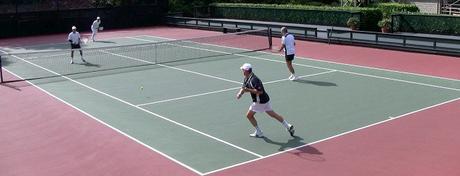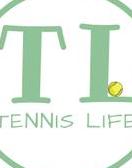
No matter what your level of play is (in both singles and doubles,) your opponent's style of play tends to dictate how you choose to return a serve, and knowing how to handle the three main styles will give you the upper hand during your next match.
Tennis players typically encounter opponents who either like to serve and volley, and those who like to serve the ball and stay on the baseline. There's also the occasional yet frustrating lefty, whose spin is the opposite of what we're used to.
So take these tips to heart, and you'll not only find yourself more confident in your return game, but winning more matches, as well.
If The Server Is A Baseliner...
If your opponent stays back at the baseline after they hit the serve, this is a good indication that they don't like coming into in to the net. This gives you some options to take them out of their comfort zone.
In singles, the best return option is the chip and charge. When you come in to the net, you not only cut off much of the court for a good passing shot, but you'll give yourself good opportunities for put-away volleys. This is not a good shot choice, however, if your opponent likes to lob.
Again in singles, another great shot choice is down the line (especially to their backhand.) They will have to hustle and take that next shot on the run - if they can get there in time.
In doubles and singles, you can also block the ball back short, forcing them to come into the net. Your next shot could be a lob, which would force the opponent back to the baseline, giving you a chance to take control of the point.
Something fun that I like to do to baseliners is to block the serve short (near the service line is perf), and force them to come in. When your opponent come in to get the shot, you (or your partner, if doubles) should opt for a deep lob on your next shot, and come in to the net. This will force your opponent(s) back to the baseline, giving you a chance to take control of the net and the point. This works well for both singles and doubles.
If The Server Is A Serve And Volleyer...
Going up against serve-and-volley players is when the return of serve becomes difficult for a lot of people. All of a sudden the serve is coming, and so is the opponent, bringing immediate pressure. A poor return pretty much means the point is over; however, there are some things you can do which may set you up for a passing shot.
Most club level players don't bend down very far to make a shot, so hit your return with lots of topspin and at your opponent's feet, and then follow it in. This will likely result in your opponent hitting a high ball that you can use as a passing volley. If the serve is a bullet and you have to block it back, try to go down the line or at the feet of the server.
Also, don't be afraid to lob, especially if the opponent likes to sprint to the net right after the serve. Keep them honest and lob the ball deep and towards their backhand side, eliminating the chances of it becoming an overhead gift for the server. If your playing doubles, lob deep over the person already at the net and force both opponents back and away from the net.
If The Server Is A Lefty...
Playing against lefties can be rough. I know this because my doubles partner is a lefty and I've seen her intimidation in action.
One of the biggest weapons a lefty has is the serve. The spin is opposite to what you'd expect from a righty. Their slice spins into you rather than away from you, making it more difficult to return.
First thing first. Keep your eyes on the ball and get your racket back early for good preparation. Regardless if the server is hitting a slice serve, topspin, or kick serve, take the ball on the rise whenever possible. The longer you wait to hit it, the more it will spin into (or if it's a kick serve, away from) your body, making it harder to return.
The way you return against certain players will set up the point and start to set the pace for the match. You don't have to hit big returns to be effective, you just need to hit smart. Returning deep against some players and hitting the return at other player's feet are two ways to neutralize attacks and stay in the point.


